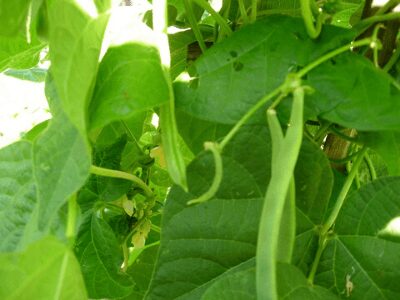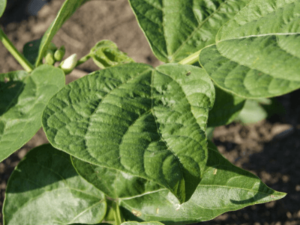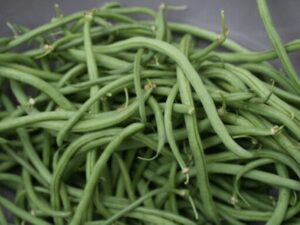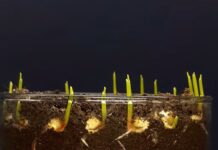
Introduction to Organic Beans Cultivation
The Beans belong to the family Leguminosae. We are considered healthy vegetables because they have high vegetable protein content. The green tender pods are used as dry seeds and as vegetables. The drying beans are grown until the seeds of the Beans are large enough and the pod begins drying. The pods are shelled, and the seeds are then removed. Organic beans are produced and processed without the use of pesticides and synthetic fertilizers.
All varieties of Beans withstand a wide range of conditions. As a result, they are dependable crops in backyard vegetable gardens that produce an abundance of pods. Bush Beans tend to be compact and grow close to the ground. Climb the Pole Beans and require a trellis or other support. Within a shorter time, Bush beans appear to produce more beans, while pole beans can also yield a whole season.
Guide to Organic Beans Cultivation Practices
Organic gardens are growing in popularity as individuals understand the multiple benefits to themselves, the ecosystem, and other living creatures. Organic farming involves not using fertilizers, insecticides, or pesticides of synthetic or natural origin. Organic agriculture adheres to fertilizers produced from by-products of animals or crops and becomes innovative when dealing with unwanted pests using beneficial insects or plants that discourage unwelcome visitors.
Not only does an organic garden cause less harm than traditional gardening, but it does also have many benefits in fact;
- Organically produced food helps with its higher essential vitamins and nutrients, to defend against cancer.
- You ingest fewer chemicals by consuming organically grown food.
- Organic gardens feed the soil rather than deplete it.
- Most organic gardeners use compost so the amount of waste that goes into landfills is that.
Also, See Guide To Organic Farming Methods
Types of Beans
Dry beans, snap beans (also known as green beans), and soybeans are the main types of organic beans. The mature dry bean seeds serve as a source of protein in a number of foods around the world. The same species are dry beans and snap beans while dry beans are distinct from snap beans or green beans that are eaten as immature pods. Dry and snap beans are separate from soybeans, where the seeds are consumed in a variety of processed ways such as tofu, soybean meal and oil. The dry beans are divided mainly into classes with a variety of seed sizes, colors, and shapes. Examples include black beans, pintos, shellfish, small red beans, and kidney beans. In general, soybeans are classified into two classes, feed grade and food grade, with food-grade comprising soybeans for processing, “tofu-beans,” and edamame, the latter being eaten as immature beans.

Snap Beans – The most popular garden beans include bush and pole varieties, which differ in form, size, and color. Tender filet beans are a sort of green snap bean with delicate, slender pods. As with other snap beans, they are grown. The growth period is 50-55 bush days, 50-67 pole days.
Dry soup Beans – Dry soup beans grow like snap beans, but the immature pods remain tender only for a few days as the plants rush to produce mature seed. They dry easily. The growth period will be green for 55 days, and dry for 85 days.
Scarlet runner Beans – These Beans produce showy red blossom clusters that attract hummingbirds and bumblebees. You can eat the young pods like snap beans, or you can dry the pods and harvest the mature Beans. The growth period will be green for 60 days, and dry for 90 days.
Lima Beans – Lima Beans stand up to heavy insect pressure and humid heat, making them a fine bean for warm climates. The growth cycle will be bush 75 days, pole 85 days.
Yard-long Beans, or Asparagus Beans – With their long, slender pods, which are harvested at 12 to 18 inches long, yard-long beans are grown. Pods may be black, brownish, or streaky. The growth duration is expected to be 80 days.
Tepary Beans – Tepary Beans are a type of dry bean, produced by the Southwest native peoples, so they are well adapted to desert conditions. We come in different colors.
Soil requirement for organic Beans cultivation
It needs well-drained loamy soil with a pH of 5.5-6.0. It likes cool weather, and beans can grow very easily. Although in the moderately rich soil they are at their best they do well in a large variety of soils, even without fertilizers. The addition of wood ashes, dolomite lime, or compost in acidic soil (below a pH of 6.0) will moderate the acidity by its alkaline nature. Nitrogen must be added in a very sandy soil that easily leeches nutrients, but bears in mind that too much can promote excessive leaf growth, plus delay and decrease pod development.
Planting time of Beans
Bean seeds can best germinate when soil temperatures range from 60 to 70F. In spring, sow seeds of Bean in moist, well-worked soil beginning on or after your last date of frost. Make additional plantings at 3-week intervals until mid-summer, when growing fast-maturing bush snap beans.
Beans are a warm-weather crop and by making them shiver during their early plant growth, there is little to be achieved. Growing on a small scale, planting Beans in raised beds saves plenty of work and energy. During spring the elevated beds heat up faster to allow earlier sowing. Beans soaking in advance isn’t usually worth it even as they go into cold soil. This starts only for the late season because of the presoaking in cracked seed and more difficult sowing.
How much space we should leave between Bean Plants
Many people leave their Beans with too much space to expand when they only need 4 to 7 inches of space between them anywhere. Ensure sure the rows are thin by pruning smaller sprouts away, then the strongest plant remains. It avoids crowding and one inch deep Beans should also be planted.
Planting method of organic Beans
Two weeks before planting, compost, or fertilizer work at a spot that gets full light. Instead, in spring, Bean plants seeds directly into fertile, fast-draining soil after the soil has warmed up. For bush beans, shape one-inch deep furrow and position every few inches of Beans. Place the trellis or Bean teepee before planting the Bean seeds for pole Beans. In each 1-inch furrow, plant several Bean seeds. Fill soil and water well with all Bean seeds.
Prepare the planting spot, then use a garden fork to loosen the dirt. Mix in a mature 1-inch layer of compost. Plant seeds roughly 1 inch deep and 2-4 inches apart. Small bush Beans about 4 inches apart; small pole Beans about 6 inches apart from each other. Broad double rows (two parallel rows of beans planted 12 to 14 inches apart) are the space-efficient way for Beans to grow.
Keep the soil moist before seeds from the Bean germinate. When seedlings germinate, spread them carefully into one plant every 6 to 8 inches. Then apply a generous layer of mulch around the plants to maintain moisture and prevent the growth of weeds. Bean plants need about 1inch of water a week. They have to be watered in the morning, so that the leaves have time to dry before dark. For the first 6 weeks, fertilize bean plants every 2 weeks with organic fertilizer, then once every 3 to 4 weeks. Keep an eye out for bean beetles, which are selected by hand and finished easily.
The plants need daily water and full sun. In general, bush beans grow faster than pole beans and are less susceptible to drought and severe temperatures. Providing protection in the form of a trellis or pole for the vines.
 Fertilizing of organic Beans
Fertilizing of organic Beans
For an organic one, lacking a chemical fertilizer decides whether to destroy the soil or make it healthier. For healthy plants, good soil is required to use organic plant fertilizer. For example, nutrient solutions such as compost teas, worm teas made from worm casts as well as liquid organic fertilizers and bat guano provide good plant nutrition and plant health overall.
Such organic fertilizers do not burn plants better than conventional fertilizers and will promote the growth of essential soil microorganisms when they are fertilizing. Timing is important while fertilizing, as the nutrient needs of Bean plants change as the plant grows. Annual plants, benefit most when fertilized with a solution rich in nitrogen when first planted (for growth and production of the leaves) and then transferred to a low-nitrogen, rich-phosphorous solution to promote blooming.
Nutrient requirements
Beans need limited fertilizer relative to other hot season crops, partially because of their ability to fix their own nitrogen. Using our own blend of organic fertilizer liquids. The second application of nitrogen-rich fertilizer is helpful if the leaves of the Bean plants start yellowing at mid-season. Organic matter helps Bean plants grow. Compost, whether homemade composted materials or compost bought, adds nutrients to the bed while helping with drainage. Beans do not tolerate soggy soils so it is especially in clay soils that the beds are composted.
Irrigation requirement
Irrigation must be given immediately after sowing, on the third day and once a week thereafter. A water deficiency resulting from lack of soil moisture or excessive transpiration could result in Bean pods being deformed or pithy snap.
Companion plant for Beans in organic cultivation
Both beans enrich the soil with air-fixed nitrogen, improving the conditions for whatever sort of crop you plant after the Beans have finished. In general, carrots, celery, chards, corn, eggplant, peas, potatoes, brassicas, beets, radish, strawberry, and cucumbers are mostly a good companion. Beans are ideal for heavy consumers of nitrogen such as corn and grain plants because at the end of the season when the Bean plants die off, the nitrogen taken up by the corn and grains is replaced. Summer savory deters bean beets and improves growth as well as flavor. And keep the Beans off the alliums.
Weed management in organic Beans cultivation
Weeding should be performed 20-25 days after sowing and 40-45 days after. Upon thorough weeding the crop must be earthed up. For the creeping varieties, fix 5-6 foot high sticks close to each hill and encourage the plants to climb.
Pests in the organic Bean crop
Many of the raising Beans pests are aphids, beetles from Japan, beetles from Mexico Bean, etc. As soon as you see these pests you can handle them by hand. You may also use organic homemade pesticides to combat bean pests (some organic materials commonly used to prepare organic pesticides are garlic, onions, chili, soap, neem oil, baking soda, and diatomaceous soil, etc.)
Major insect pests in organic Beans cultivation
Insects are another major contributor to organic beans producing losses. There are several instances of insects impacting organic Bean structures including;
Bean and potato leafhoppers – Sucking insect that causes yellowing of plant leaves at the tips and edges and can cause stunting
Western Bean cutworm – This insect’s larvae feed on Beans’ pods reducing crop yield and quality
Soybean aphid – A sap-sucking insect that forms large soyBean colonies. Soybean aphids can spread viruses during feeding, from plant to plant.
Seedcorn maggot – Feed on dry beans and snap seed from bean and seedlings. There is an increased risk of feeding when the temperature ranges are cool and the soil is moist.
Insect pest management
As a general insect management method, Neem cake is applied by 250 kg / ha after 4-5 weeks of sowing. For stem fly control, which causes major losses, spray neem oil at 10, 17, and 23 days after sowing by 5ml / lit. Pest control must be achieved in organic beans without using synthetic herbicides, fungicides, insecticides, and other pesticides.
Major weed pests in organic Beans cultivation
The main costs of agricultural production systems, including organic beans, are weed control. Weeds can reduce organic Beans’ emergence, production, and yield as they compete for light, water, and nutrient resources. Weeds are classified in different ways, for example by life cycle. The most troublesome weeds of summer annual and seasonal life cycles are in the organic Bean crop.
Perennials
Perennial weeds can live for several growing seasons, because of hardy rootstocks in general.
Disease management
Rot apply Trichoderma harzianum by 10 g / lit at an interval of 10 days to control foliar disease (rust and leaf spots) and berries.
 Harvesting organic Beans
Harvesting organic Beans
Anyone blessed with a dry, sunny site can have a bean crop that dries in the garden to perfection with short-season varieties The leaves of the plants fall off, and the pods turn brown. The Bean pods start spilling their Beans on hot late-summer days. And pick them out before too many fell. To ensure the Bean pods are thoroughly dry, bring them to a moist, dry place with good air circulation indoors. Some varieties grow over a week or two, so it is best to go through the patch every couple of days to pick the driest.
Look carefully at plants as beans begin to shape and harvest every 2 to 3 days. Beans are ready to pick when the pods are well-shaped and flattened, and when bent in half, snap readily. If Beans are left too long on the plants, the Bean seeds will overdevelop and the pods will become tough. Poorly produced pods are caused by too dry soil, too low infertile soil, or damage to insects. When the pods are well filled and green in color, Lima Beans are selected. The Beans are too mature and left on the vine if the pods are yellowing and picked later to use as dry beans.
The yield of Beans in organic cultivation
Approximately 12 to 15 tons/ha of marketable Bean yields can be obtained by implementing good technology for organic growth.
The Conclusion
Any or all of the above knowledge can be used to grow organic beans in polyhouse, organic beans growing in a greenhouse, organic beans growing at home in pots or containers, organic cluster beans farming, organic yard beans growing, organic soya beans growing, organic lima beans growing, organic runner beans growing, and organic snap beans growing.
Also, See Organic Farming | Basic Steps of Organic Farming, Methods, and Benefits

 Fertilizing of organic Beans
Fertilizing of organic Beans Harvesting organic Beans
Harvesting organic Beans




